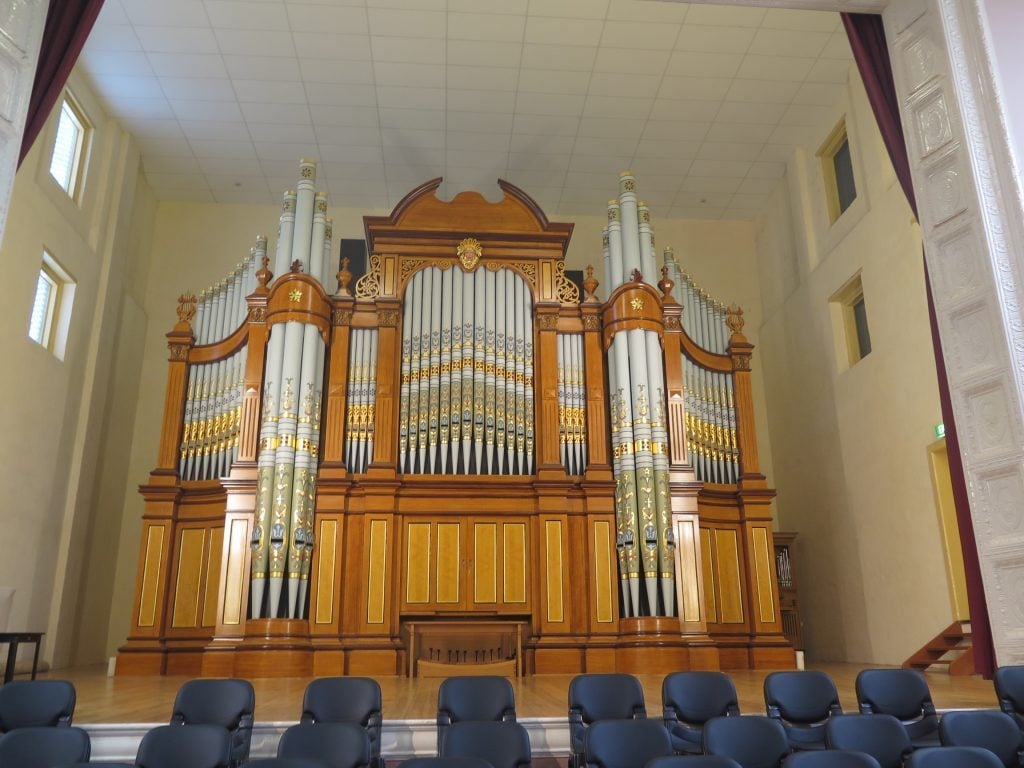The fabulous 1877 Hill & Son Grand Organ in the Barossa Regional Gallery
CLICK ON IMAGES TO ENLARGE
03 November 2017
This morning we decided to have breakfast before we start exploring, and there is a cafe just around the corner. Our decision was to have smashed avocado with tomato relish, topped with scrambled eggs, and it was a great way to start our day.
We decided to begin exploring Tanunda, which seems to be the busiest of the three towns in the area including Nurioopta and Angaston. There are certainly more shops and cafes in Tanunda, and after visiting the Information Centre, we were armed with enough information to start exploring. A wander along the main street found me at the site of the oldest house in Tanunda (left) built about 1856.
 While today Tanunda is the cosmopolitan heart of the Barossa, it started life far more humbly as the tiny settlement of Langmeil located on the banks of the North Para River, to the north of the present-day town. Langmeil (‘Long Mile’) was settled in 1843 with a school house as their first public building followed soon after by the Langmeil Church. As the settlement grew and prospered it joined with, and was eventually incorporated into, the town of Tanunda. Visitors to Tanunda can experience a whole cross section of the Barossa good life here, with an ever-growing cluster of cafes, restaurants, butchers, bakeries and cellar doors providing a glimpse into the Barossa’ famous food and wine offering.
While today Tanunda is the cosmopolitan heart of the Barossa, it started life far more humbly as the tiny settlement of Langmeil located on the banks of the North Para River, to the north of the present-day town. Langmeil (‘Long Mile’) was settled in 1843 with a school house as their first public building followed soon after by the Langmeil Church. As the settlement grew and prospered it joined with, and was eventually incorporated into, the town of Tanunda. Visitors to Tanunda can experience a whole cross section of the Barossa good life here, with an ever-growing cluster of cafes, restaurants, butchers, bakeries and cellar doors providing a glimpse into the Barossa’ famous food and wine offering.
In addition, a smart, high quality retail sector caters to those who may have taken their epicurean fill for the day. Tanunda is also a particularly family friendly town, with numerous parks, playgrounds, picnic spots and activities such as bike hire. The Tanunda Heritage trail is well sign-posted throughout the town and will reward those on foot who wish to take in this green, leafy town at a slightly slower pace. The Tanunda Hotel (left) has pride of place in the main street.
We were keen to see the Barossa Regional Gallery where there is currently an exhibition by Yidumduma Bill Harney. Born at Brandy Bottle Creek on Willeroo Station, Northern Territory in the early 1930s, his mother was a Wardaman woman and his father a stockman, storyteller and writer. Harney grew up with his mother and his Aboriginal stepfather, Joe Jomornji, learning the way of the Wardaman people including bush foods, tool making, hunting, fishing, culture, language and stories. He escaped being one of the stolen generation by his mother covering his skin in black plum and hiding in a remote area so that patrol officers could not find him. Unfortunately, his sister was not so lucky and was taken by the Aborigines Welfare Board.
Harney has also extensively travelled in his pursuit of sharing his knowledge with the world. He has performed the traditional music and stories of his people at venues including Sydney Opera House, Darwin Festival, Sacred Music Festival California, and other universities and festivals around the USA. While he grew up painting, Harney didn’t formally enter the art world until the late 1980s. Since then he has been a finalist in the National Aboriginal and Torres Strait Islander Telstra Art Awards eleven times. His works are held at the National Gallery of Australia, Federal Parliament, the Northern territory Parliament, Bond University and the University of Sydney.
Another highlight at the gallery is the 1877 Hill & Son Grand Organ originally built for the Adelaide Town Hall. The Adelaide organ was enlarged in 1885 and much was rebuilt and altered in 1970. Replaced by a new organ in 1989 the Grand Organ was removed from the Adelaide Town Hall and placed in storage, its fate uncertain. The Organ Historical Trust of Australia expressed interest in the organ and was given possession by the Adelaide City Council on condition the organ be restored and located in South Australia.
There are many heritage buildings in Tanunda, and I walked along part of the Tanunda Town Walk to discover some of them. What really impressed me were the gardens, and the heady perfume as I wandered around some of the older streets. Almost every garden had wonderful displays of roses, roses everywhere! This is repeated in Nurioopta and Angaston. In addition there were hollyhocks, honeysuckle, jasmine, geraldton wax, lavender – beautiful cottage gardens.
After leaving Tanunda we drove through the tiny town of Bethany, then attempted to find the Mengler Hill lookout, but one thing we have found in South Australia is the lack of information on signs, and the Mengler Hill lookout avoided us! Maybe we will find it tomorrow. In the meantime we drove on to Angaston where we had a pleasant late lunch before attempting to find the Seppeltsfield winery (closed for the day) before returning to the motel. We have discovered that there are few places to eat in Nurioopta except for the Motel facilities, so we will need to do some more searching tomorrow for a different place for dinner.
Tomorrow there is a farmers’ market at Angaston and we plan to visit there after breakfast, and catch up with any other sites that we have missed.












